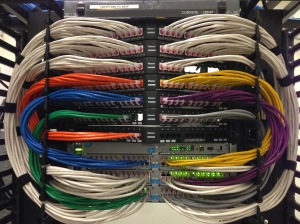A Proven EdTech Recipe For K12 Success
Building a sound computing environment that provides “enterprise class” services for schools on a California budget isn’t rocket science. It involves making smart choices and focusing on what’s important.
- Plant some cable. It’s the foundation for everything. Crap cable equals a crap network.
- Wifi like starbucks. Instant on and connected to the web. Buy the features you need, and honestly, you don’t need that many. Less is more in school wifi (except when it comes to APs in the classroom). You need easy guest access, preferably with all IP/DHCP/Nat services handled by the wireless system and you definitely need per SSID bandwidth throttling. It should be super easy to enable these features and everything should just work. Meraki was the easiest wifi I have ever setup and it had the best management UI, period. Ruckus had the best APs I’ve ever used. I wish they would marry and have a kid. Beyond that, I’ve been less than impressed with any other wireless solution on the market.
- Go Google. Google Apps for Education. It’s a no brainer and the only reason not to do it is because your IT Department loves Microsoft (or hates Google) and thinks Office365 is a viable alternative for teaching and learning (um, nope).
- Web Filter less. Less is more. CIPA does not require that we filter twitter or YouTube. So why get fancy with expensive solutions. Go simple. Untangle worked for me for many years both as a web filter and a firewall. I even ran the free version for a few years. That’s right. Free.
BIGBaby Iron. Virtualize and reduce those big noisy expensive servers. Go Open Source if practical, Hyper-V if not and VMWare with VCenter as a last resort (It’s expensive). I’m still trying for a Zero Server Server Room design but keep getting stuck with Active Directory (AD) servers everywhere.- Store it somewhere cheap. Cloud is preferable but those virtual servers still need on premise storage. Local is easy. Nimble Storage is easy too, and fast. And big. And did I say easy to setup? I don’t usually design for a SAN but when I do, I use Nimble. A FreeNAS box works too. Especially as a cheap iSCSI backup target.
- MacBooks for teachers. Because. No, really. Because. Teachers are highly educated creative professionals. They can (and should) manage their own updates and applications and because MacBooks just work even when everyone is a local admin.
- iPads too. Yes. For teachers. With a tablet stand. And a mounted projector or big LED TV. And an AppleTV. Hardwired to the network. Because it works and it’s magical. Special training not required (in most cases).
- Chromebooks for kids (or ubermix if you can pull it off). Because. Because again they just work (sense a theme yet?). They can be supported at scale and they get kids connected.
- iPads too. Yep. iPads. Because they’re iPads. Have you seen all the apps? Just don’t go iPad crazy. They’re still harder to support than a chromebook.
- BYOD. For everyone. Why not? Build the network and they will come. (Don’t forget to get more bandwidth and really big subnets before you open things up to the world).
- Ditch the NAC. Access trumps security and control is an illusion. We’re schools, not banks. Complexity is not our friend. Inform, train and trust users and they will do what is right the majority of the time. Help the ones that don’t.
This way lies reliable, scalable access for learning. Don’t buy the biggest or the best at the expense of kids. Not when every dollar spent on “enterprise class” is a dollar less to spend on devices for kids. And reliable access doesn’t require “enterprise class” just “enterprise enough”. Unless you’re LAUSD or SFUSD. Then you’re pretty much out of luck. No matter your environment, focus on what’s important and make smart choices. Everyone will thank you for it.
Oh yeah. I almost forgot PD. Don’t forget PD. Lots of PD. Just in time PD. Individualized PD. PLN PD. Training Days PD. All kinds of PD. Lots and lots of PD. Don’t forget PD.
What else did I forget?


Bob Henderson 4:05 pm on March 8, 2014 Permalink |
I’d throw in a few options in there:
4. Untangle works great, been using for 5 years now. Just convince people to stop trying to filter 1:1’s offsite and maybe teach students how to act instead..
5. I’m a fan of Refurb Iron. Every server I have in deployment was 3+ years old before I even touched it, and obtained for at least 1/3 of the cost of new. Proxmox works great, currently running 4 clusters at various sites.
6. Never had luck with Freenas, but am a huge fan of OmniOS+Napp-IT. ZFS is a game changer, and performance comparable to that Nimble box is in the ball park with the right setup.
9. Unless your state decides that the mandatory testing software only runs on Windows/Mac, and won’t support it in an RDP session…
Brian Bridges 8:06 am on March 14, 2014 Permalink |
Brilliant!!!!!!!!!!!!
Filtering for Learning - JoeWoodOnline 9:27 am on March 17, 2014 Permalink |
[…] philosophy isn’t isolated to Natomas Charter School. Also, Andrew Schwab wrote an amazing, related post just last week. There are educators and community leaders throughout the United States who are […]
Mr. Caplan 2:26 pm on April 21, 2014 Permalink |
Big fan of this article and its philosophy. There are different kinds of ‘easy’ and to create a good one usually takes a lot of hard work!
Brian Turner 12:50 pm on May 5, 2014 Permalink |
In addition to PD, i would add support. Tech integrators if possible to support the efforts in the classroom. Help desk personnel or students to help students and teachers. PD for your help desk personnel. PD for your network and server admins.